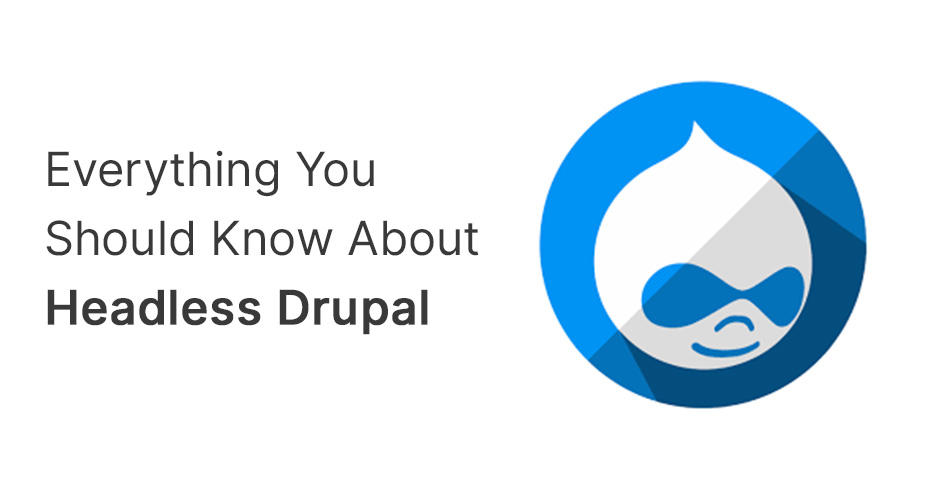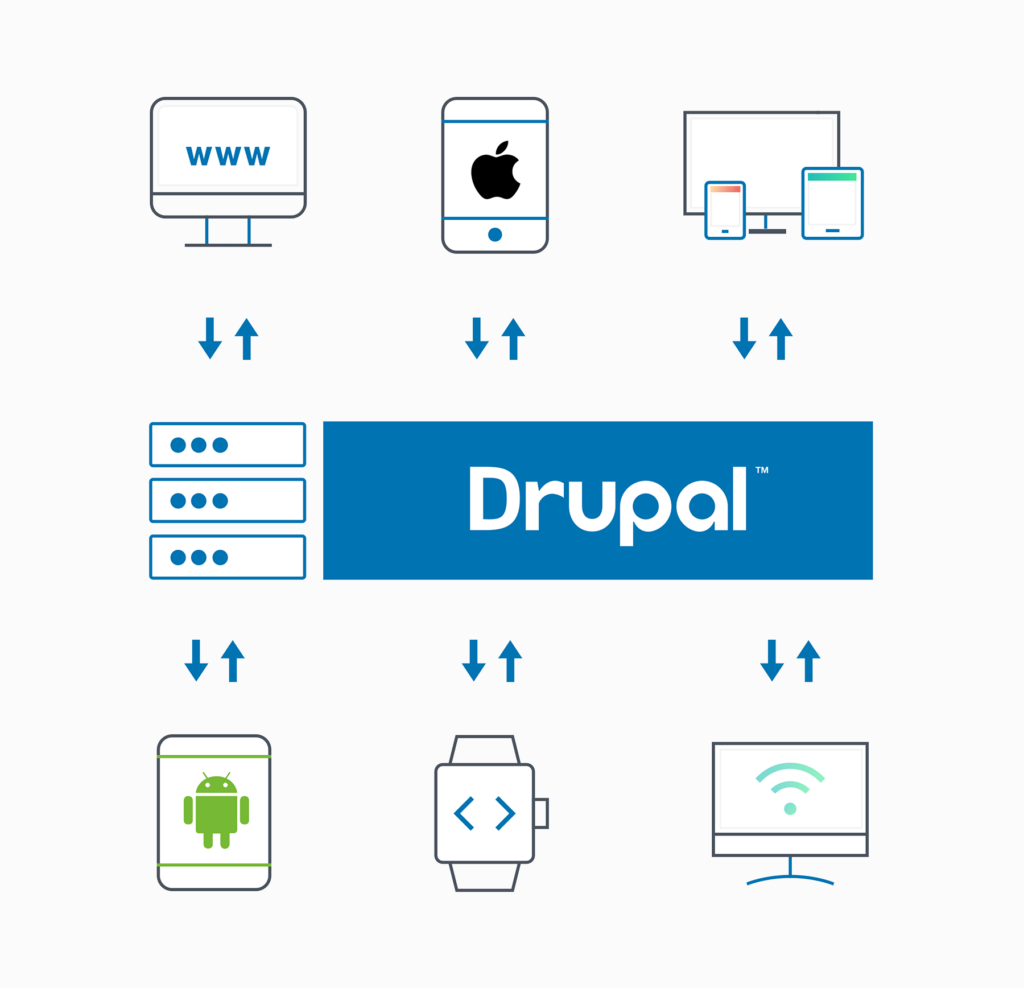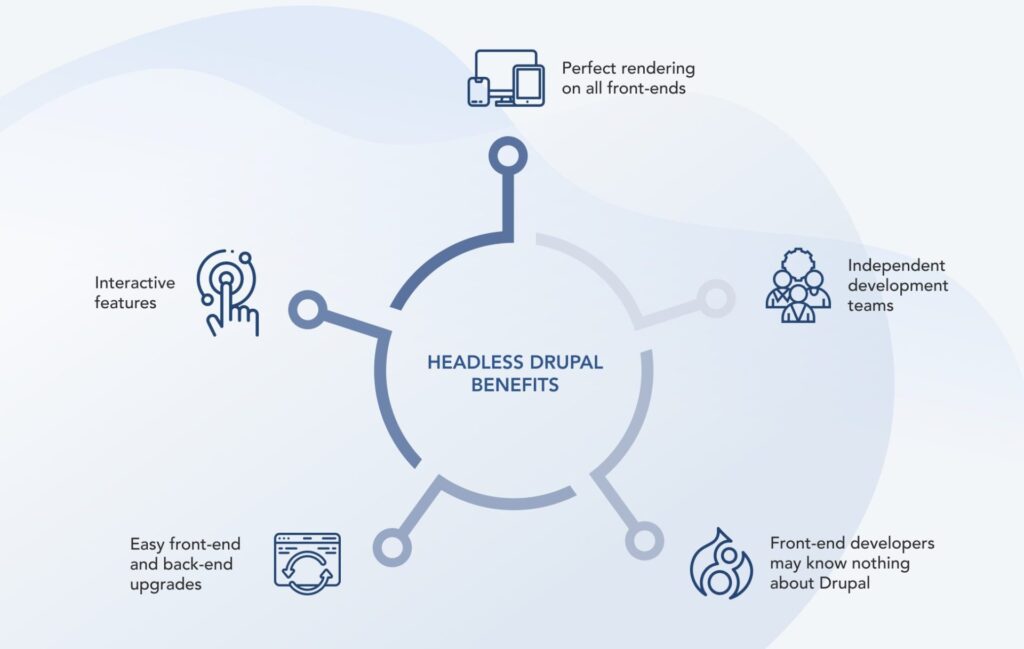Everything You Should Know About Headless Drupal

Introduction
You can manage and deliver the content in a more efficient way using Headless Drupal. This powerful platform offers a number of advantages over traditional Content Management Systems. In this blog post, we will discuss what Headless Drupal is, and how it can benefit your business. You will get the answer to all your questions about headless Drupal and why it is such a powerful tool. We’ll also provide some tips on how to get started using this platform.
A traditional Drupal website is responsible to provide customized end-to-end solutions for users. The prime objective of Drupal is to create, display, and store content for the end-users. However, using a Headless Drupal you can still create and store the content except for the display. This is because it is focused on the back-end approach of a website. The front-end of a website is based on different technologies and communicates with Drupal through API.
In simple words, Headless Drupal enables the team of front-end developers to have complete control of the UI, UX, & presentation of the website.
Where Did Headless Drupal Come From?
As the web has evolved, so has the urge to manage and display content throughout several devices and platforms. Initially, this meant linking website data to native mobile apps for display, or interfacing with enterprise-level hardware and software.
The concept of headless Drupal actually predates the platform itself. The idea was first proposed by Dries Buytaert, the creator of Drupal, back in 2007. At that time, he suggested that it might be possible to decouple the frontend presentation layer from the backend content management system. This would allow developers to build better integrations with third-party software and services.
Can Drupal Be Headless?
Drupal is a powerful Content Management System that offers several features and benefits. However, it can also be used as a headless platform. Headless Drupal refers to the decoupling of the backend CMS from the frontend presentation layer. In other words, the Drupal CMS is used to manage and store content, while the frontend presentation layer is built using a separate framework such as React or Angular. This approach offers many advantages, which we will discuss in more detail below.
What Is Headless Drupal?
In a nutshell, Headless Drupal is a platform that allows you to manage and deliver content without a traditional web browser interface. This can be done through various methods, including APIs or other specialized software. By using Headless Drupal, you can create more efficient and streamlined workflows for managing your website.
What Are The Objectives Of Headless Drupal?
The primary objective of Headless Drupal is to decouple the backend of a website from the frontend. This allows developers to build websites and applications using different technologies, without being limited by the capabilities of a single platform.
For example, a traditional Drupal site might use PHP for the back-end and HTML/CSS for the front-end. With Headless Drupal, you could use Node.js for the back-end and React for the front-end. This flexibility provides a number of benefits, including improved performance, scalability, and security.

Image Source: Hinglish
There are seven objectives of headless Drupal:
- To make life easier for content creators and editors by providing them with a user-friendly interface that allows them to easily create and manage content.
- To make it easier for developers to create and maintain customizations and integrations.
- To improve performance by decoupling the front-end from the back-end.
- To make it easier to scale Drupal websites.
- To provide a better security model by isolating the front-end from the back-end.
- To allow for greater flexibility in how Drupal websites are designed and built.
- To make it easier to migrate away from Drupal if necessary.
Who Uses Headless Drupal?
Headless Drupal is often used by large organizations that need to manage a large volume of content. It’s also popular among developers who want more control over how their content is delivered. If you’re looking for a more efficient way to manage your website, this may be the right platform for you.
Why Use Headless Drupal?
There are many reasons why you might want to use Headless Drupal. One of the most common reasons is that it allows you to decouple your content from your presentation layer. This means that you can easily change how your content is displayed without having to make any changes to the actual content itself.
This can save you a lot of time and effort in the long run. Additionally, it provides greater flexibility when it comes to managing and delivering content. You can use different methods to deliver content, including APIs or other software. This allows you to tailor your content delivery to your specific needs.
How Does It Work?
Headless Drupal relies on two main components: the back end and the front end. The back end is responsible for managing and delivering content, while the front end is responsible for displaying it to users. This separation of duties can lead to improved performance and scalability. Additionally, it allows you to use different technologies for each component, which gives you more flexibility in terms of how you want your website to look and function.
Headless Drupal is a decoupled approach to building web applications. In a traditional “monolithic” Drupal setup, the front-end and back-end are tightly coupled together. This means that you cannot make changes to the front-end without also affecting the back-end and vice versa.
With headless Drupal, however, the front-end and back-end are completely decoupled. This allows you to make changes to either one without affecting the other.
Benefits of Using Headless Drupal For Your Online Business

Image Source: PSD2HTML
Pros of Headless Drupal
There are a number of ways that Headless Drupal can benefit your online business. Here are some of the most notable advantages:
Increased Efficiency:
Headless Drupal can help you manage and deliver content more efficiently. This is because it separates the back end and front end, allowing you to use different technologies for each component. As a result, you can create workflows that are tailored to your specific needs.
Improved Scalability:
By using Headless Drupal, you can improve the scalability of your website. This is because it relies on a modular architecture, which allows you to scale each component independently. Additionally, you can use different technologies for each component, giving you more flexibility in terms of how your website scales.
Enhanced Functionality:
Headless Drupal offers a number of features that can enhance the functionality of your website. For example, it includes a robust API that allows you to easily access and manipulate content. Additionally, it provides a wide range of tools for managing and delivering content.
Greater Flexibility:
Headless Drupal gives you greater flexibility in terms of how you want your website to look and function. This is because it allows you to use different technologies for each component. As a result, you can create a website that meets your specific needs and requirements.
Easy To Function:
Headless Drupal is easy to use, even for beginners. This is because it relies on a modular architecture and a wide range of tools. Additionally, it offers a robust API that allows you to easily access and manipulate content.
Cons Of Headless Drupal
Even though Headless Drupal has a lot of advantages, it also has some disadvantages. Here are some of the most notable drawbacks:
Lack Of Documentation:
One of the biggest drawbacks of Headless Drupal is the lack of documentation. This can make it difficult for beginners to learn how to use this platform. Additionally, it can be challenging to find answers to specific questions.
Complicated Workflows:
Another downside of Headless Drupal is that it can create complicated workflows. This is because it relies on a modular architecture and a wide range of tools. As a result, you need to have a good understanding of how each component works in order to create an efficient workflow.
Lack Of Support:
Another drawback of Headless Drupal is the lack of support. This is because it is a relatively new platform and there are not many people who are familiar with it. Additionally, there are not many resources available for troubleshooting.
Overall, it has a lot of advantages that can benefit your online business. However, it also has some drawbacks that you should be aware of before you decide to use this platform. If you have the time and patience to learn how to use this platform, then Headless Drupal can be a great option for your website.
How To Get Started With Headless Drupal?
Now that you know all about Headless Drupal, how do you get started using it? Here are some tips:
Install The Core Modules:
The first step is to install the core modules. These modules provide the basic functionality needed to run a Headless Drupal website. You can find these modules in the Drupal module repository.
Configure The Back End:
Once the core modules are installed, you need to configure the back end. This includes setting up the database and user accounts. Additionally, you need to configure the file system and web server.
Configure The Front End:
After the back end is configured, you need to configure the front end. This includes setting up the theme and creating custom blocks. Additionally, you need to add content types and fields.
Test Your Website:
Once everything is configured, you need to test your website. This includes testing the back end and front end components. Additionally, you need to test the functionality of your website.
Is Headless Drupal For Everyone?
No, Headless Drupal is not for everyone. This is because it requires a significant amount of time and effort to learn how to use this platform. Additionally, it can be challenging to find support if you encounter problems. However, if you are willing to invest the time and effort, then it can be a great option for your website.
Is Drupal A Decoupled CMS?
Drupal is a content management system (CMS). In its early days, it was known as a monolithic CMS. That’s because it consisted of one large codebase that handled both the back-end and front-end of websites.
In recent years, however, Drupal has become more decoupled. This means that the back-end and front-end are now separate entities. The back-end still powers the website but the front-end is now powered by another application, such as a JavaScript framework.
This decoupling has many benefits, one of which is increased productivity. When you don’t have to worry about the front-end while working on the back-end (or vice versa), you can get more work done in less time.
What Is The Difference Between Headless Drupal And Decoupled Drupal?
The difference between headless Drupal and decoupled Drupal is that headless Drupal does not have a front end. This means that you cannot use Drupal to create the front end of your website. Instead, you need to use a different platform for the front end. Decoupled Drupal, on the other hand, has a front end and a back end. This means that you can use Drupal to create both the front end and back end of your website.
Here are some key differences:
- A headless Drupal is a platform that uses a modular architecture and a wide range of tools.
- A decoupled Drupal is a platform that uses different technologies for each component.
- Headless Drupal is easy to use, even for beginners.
- Decoupled Drupal can be challenging to learn, especially for beginners.
- Headless Drupal offers a robust API that allows you to easily access and manipulate content.
- Decoupled Drupal does not offer an API, which can make it difficult to access and manipulate content.
Conclusion
Headless Drupal can be the best option for your official website if you are willing to invest the time and effort to learn how to use it. However, it is important to be aware of the drawbacks of this platform before you decide to use it. Additionally, Drupal is not a decoupled CMS but it can be used as a headless CMS. If you are looking for more flexibility and control over your website, then Decoupled Drupal can be a great option for you.
In case you want to discuss how Drupal CMS can benefit your business, contact Mpire Solutions for a FREE Consultation.




